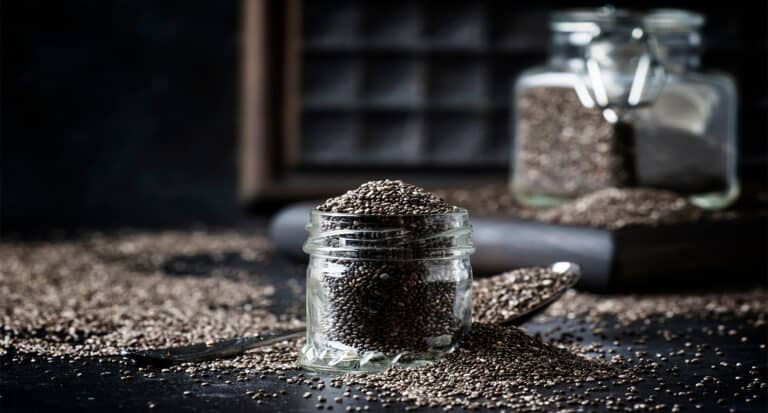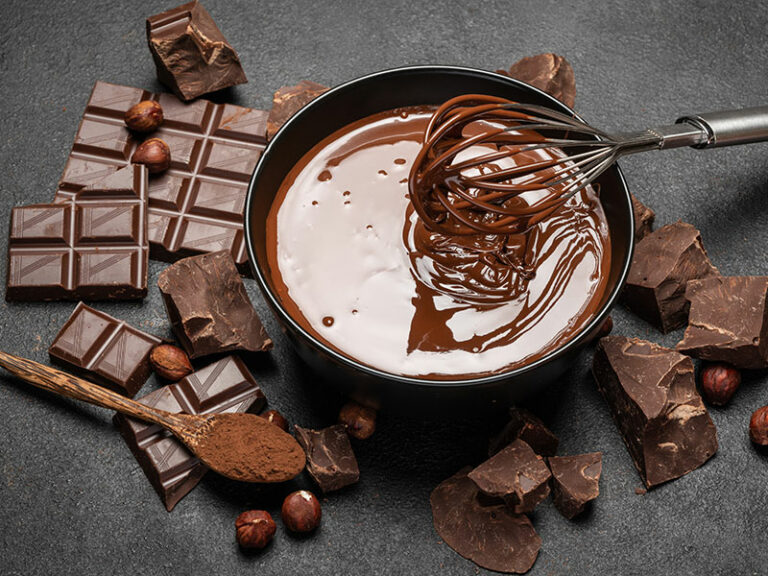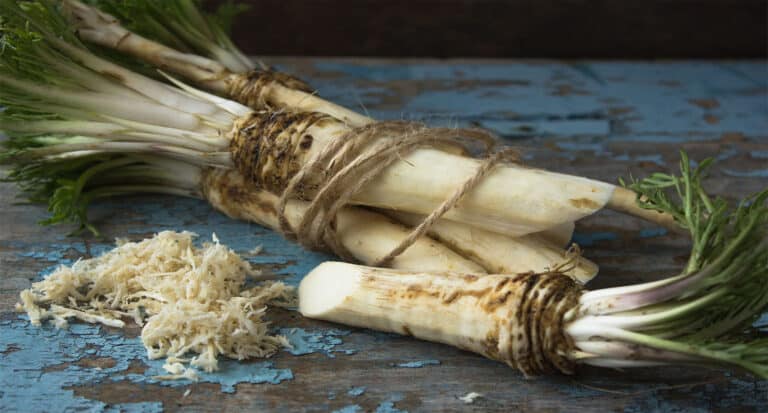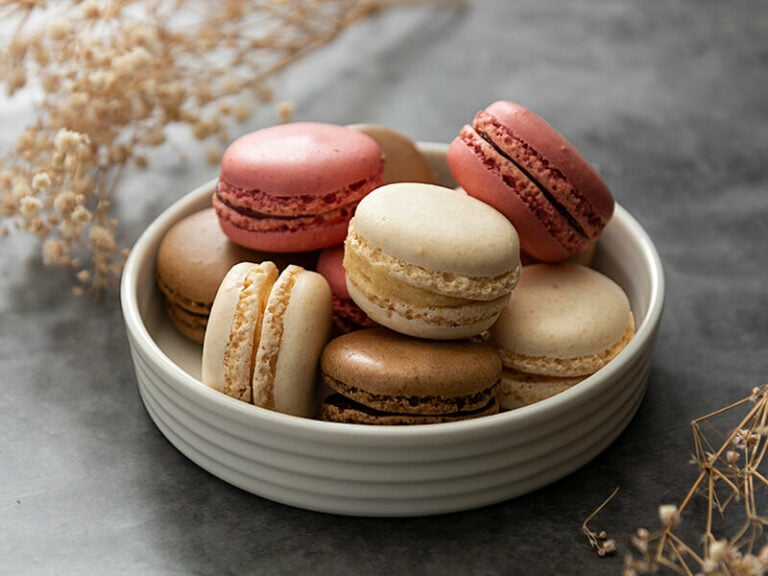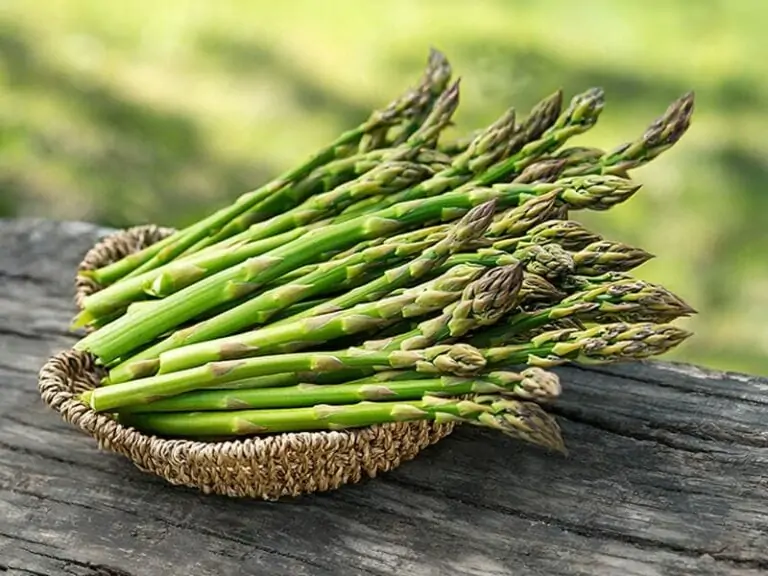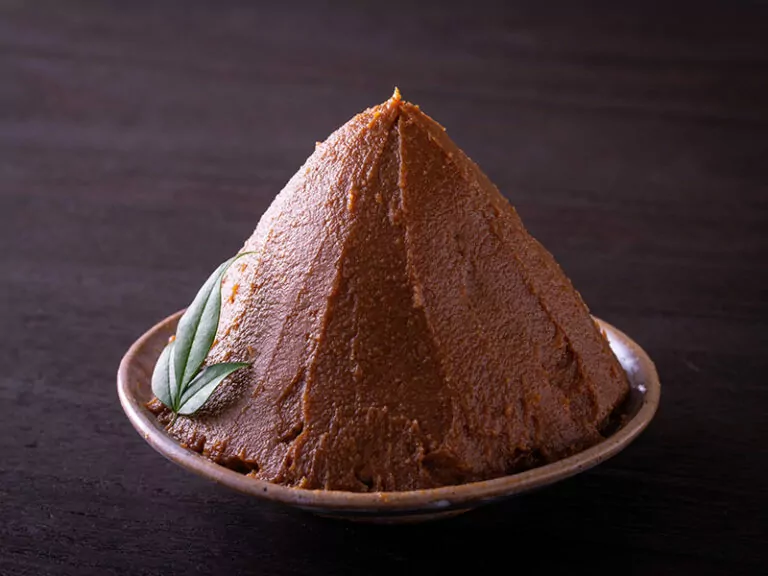Many people may ask “how to store honey?” to keep the beautiful amber liquid safe and sound. As one of the best kinds of sweet in the world in terms of both taste and health, much desirable for everyone, this is a very necessary question.
Honey is the kind of food that can last for a very long time, but that doesn’t mean you can just bring a jar of honey home then leave them anywhere.
Moreover, when you have invested in expensive raw honey to enjoy their sweetness to the fullest, it’s all the more reason for you to learn and know how to maintain that flavor of them the right way with this article.
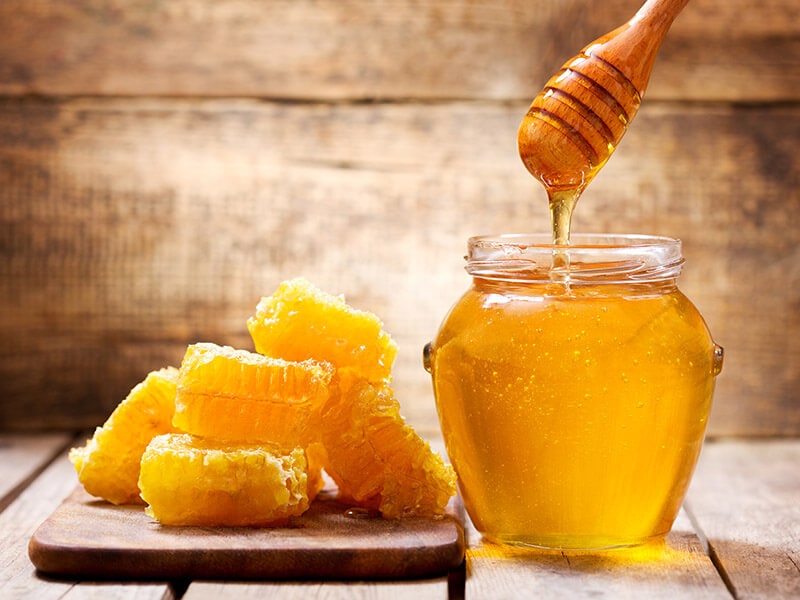
What You Should Know About Honey
To keep it simple, honey is the food that bees store for the upcoming winter.
They are largely made of flower nectar mixing with the enzymes of the bees. Although they have high levels of sugar and calories, honey is still a better choice than refined sugar while bringing much more benefits. Mainly due to the following reasons:
- Honey is just pure natural sugar, but they provide vitamins and minerals while containing little to no fat.
- Antioxidants, one of the main components of honey, are very good for health.
- Although honey is high in sugar, they are good for blood sugar levels because the antioxidant within can help to balance them out.
- Improve heart health and help prevent heart diseases.
- Assist in burn treatment and wound healing.
And the most important reason: due to their higher fructose level, you only need a small amount of honey to provide the needed flavor for your food or drink. This is the reason why many people prefer honey as their choice of sweetener over sugars.(1)
Just to show you how much people demand, in 2020, according to the USDA (U.S Department of Agriculture), there are 2.71 million honey bees colonies that generated 1.48 million pounds of honey. (2)
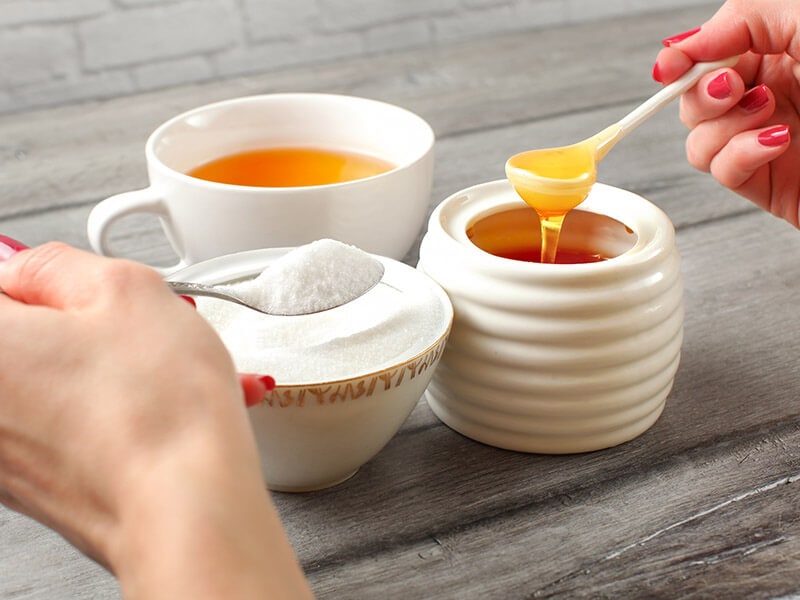
Also, because they contain high sugar levels, they tend to crystallize, ferment, attract pests by nature, and are easily affected by moisture. To deal with these problems and keep your honey fresh and good, there are things that you should look at:
- Which type of honey do you have?
- Where and how to store honey?
- The air and temperature.
- Pay attention to crystallization and fermentation.
The Ideal Environment And Container For Honey
For honey, only two things matter to them the most: the container and the environment. To ensure that honey can always be in its top shape, you must put extra thought into where you will put them and the container in which you will keep them.
Container
Anyone would need a nice and cozy house to be able to keep their best shape. This is also the same with honey.
Honey is relatively easy to preserve, but the storage condition can make them subjected to chemical and physical state change.
A good, clean, nicely sealed container is required if you wish to maintain the original quality of freshness, taste, and texture of honey. Following these small tips may help you:
- You must always keep the container in which you hold the honey tightly sealed. Otherwise, moisture from the air may get to them, and together with the sugar, they can cause them to ferment, which will affect the original taste and savor of honey.
- While it can be anything, but preferably the container should be from these materials: Glass, clay, stainless steel, plastic.
- You can also just simply store honey in the container they originally came in since they are specifically designed to hold and transport honey.
- You should not re-use old jars or containers that used to contain heavy scent objects like pickles or wine as honey can absorb the odor and ruin its scent.
- Make sure to check if there is any damage or leaking before putting the honey on your kitchen shelf.
- Larger jaws and buckets are also a method for long-term storage, they will eventually become crystalized if you store them in large quantities, but that is not much of a problem. You can still enjoy them as they are.
Besides, there are methods to decrystallize honey when you need it.
More Details On Your Choices Of Material
If you find it hard to pick what kind of vessel to put your honey in, here is a little more details for each of the best types of material you can find:
Glass Bottles Or Jars
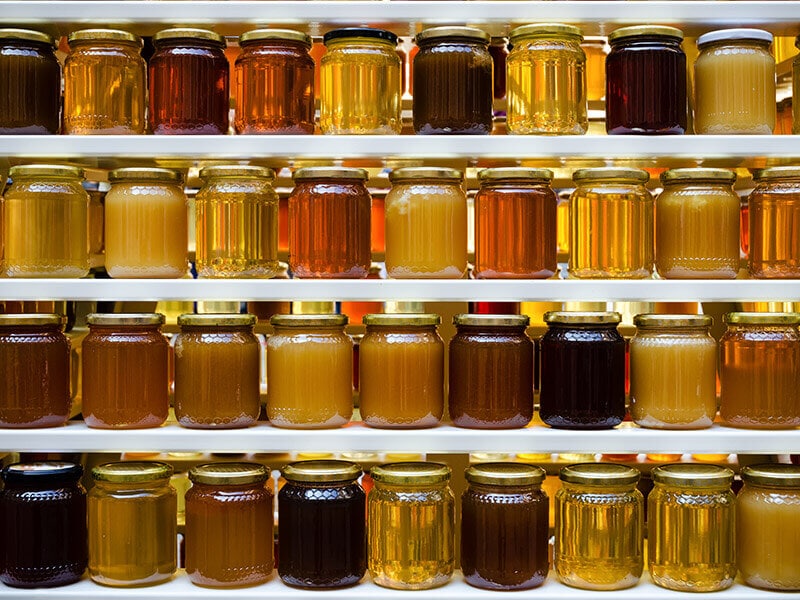
Probably the best option for you, colorless and odorless, glass helps you continuously keep the contents in check and never stain nor damage the goods inside. Moreover, a glass bottle or jar is the most formal way when you want to give them to someone.
Clay
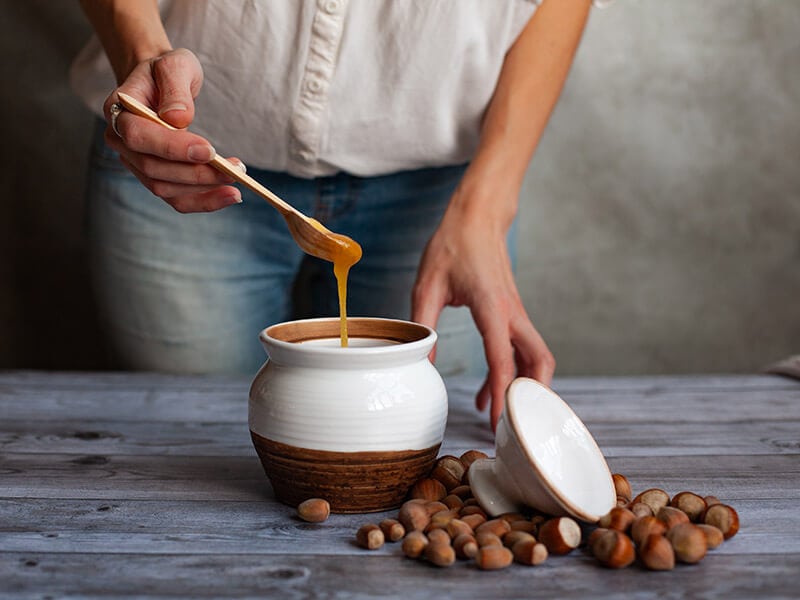
Also is a great choice since honey prefers to stay in dark, cool places, and a ceramic pot should be ideal for that. Always keep honey in a stable condition as they constantly maintain a cooler temperature than outside. If your place tends to get warm, this is your friend.
Stainless Steel
An okay alternative, and you should not use any other metal container except them to avoid the risk of corrosion that can contaminate honey.
Plastic Bucket:
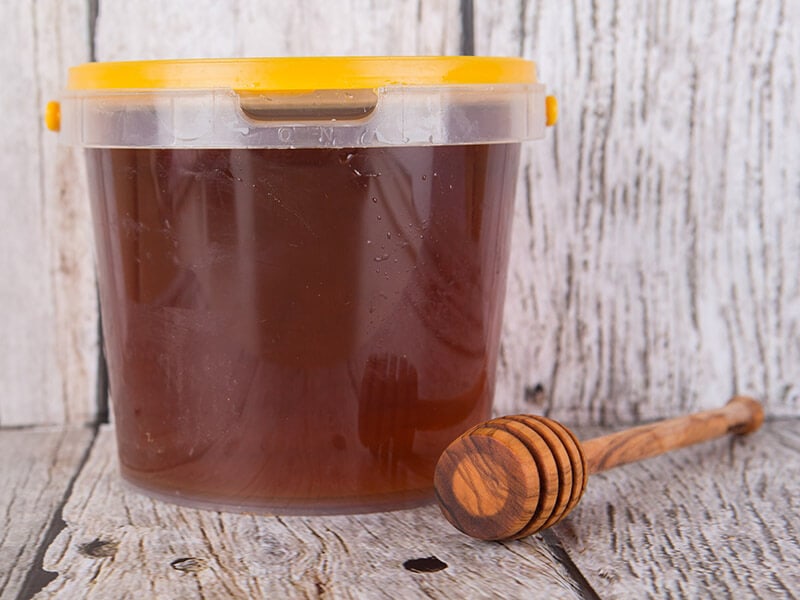
When you need to store in larger quantities, it’s hard to find a bottle or jar of that size. In this case, a plastic bucket should be taken into consideration. Although some plastic containers can leach chemicals, they are easy to obtain, and it should be fine if you choose them carefully.
Tips: If you have to use plastic as a container, make sure to only pick High-density polyethylene (HDPE) plastic.
Temperature
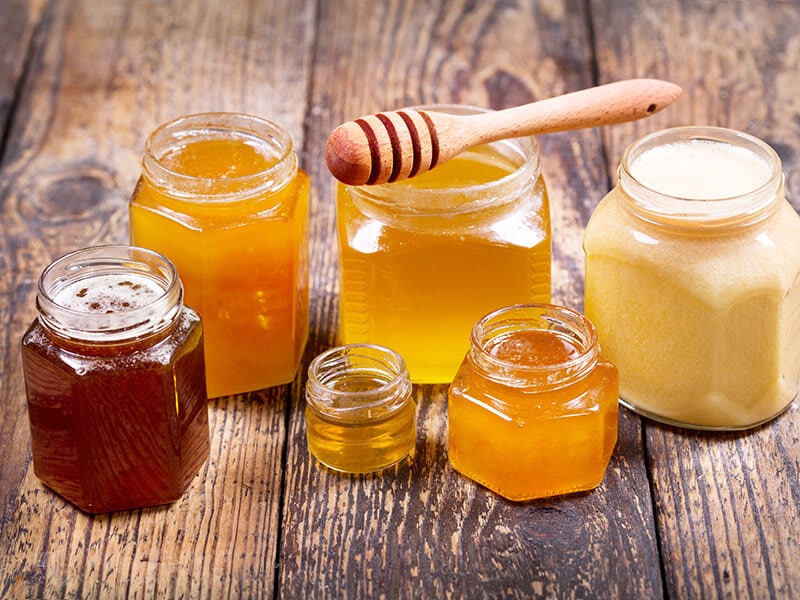
One of the decisive factors when it comes to storing honey, a simple change of temperature can leave no small effect on them, so you have to keep an eye out for this element. (3)
Theoretically, temperatures will not make honey go bad or ruin them to the point of unusable, but rather they change them in terms of physically and chemically.
Different varieties of honey will or may require a different set of temperatures to be able to maintain their best condition. With this in mind, you can also adjust the temperature of your storage place to fit certain types of honey you have or for your personal preference.
The most suitable temperature should be around room temperature, about 20 degrees Celsius. Different levels of temperature will leave different effects. They can be divided into these basic stages and can be applied to most of any kind of honey:
- Cold temperature (0°C): prevent crystallization and fermentation, but this will cause honey to solidify, making it harder to consume.
- Room temperature (around 20°C): this is the balance level of temperature that most honey products can be kept in. They can last a long time just by this, although it may lead honey into crystallization.
- Hive temperature (36°C): this should be the maximum temperature honey can be exposed to. Going higher will lead to unwanted changes in the quality of honey.
- Warm temperature (20 to 40°C): this will prevent crystallization but instead encourage fermentation.
- Hot temperature (40 to 70°C): the heat of this level will destroy the enzyme and antioxidants in any raw honey and turn them into processed honey.
- Very hot temperature (above 71°C): extreme heat will caramelize honey thus pasteurize them, cleaning most of their natural bacteria and enzymes.
Have You Stored Your Honey Properly?
Although this is not a difficult task, when you are not paying them enough attention, your honey could turn into sugar or crystallize before you even realize it. Therefore, to avoid that scenario, you should take a look at what to do here.
A Step By Step General Guide For Storing All Kinds Of Honey
Honey can come in various types, but its components and nature are largely the same. This means that the same basic step of storage can also apply to most of them.
Firstly, you should know that it is completely fine to leave honey in its original container when you buy them since these are also designed to store honey specifically.
But when you need to transfer them all together to a larger one for better keeping, following these steps here will save you a lot of headaches:
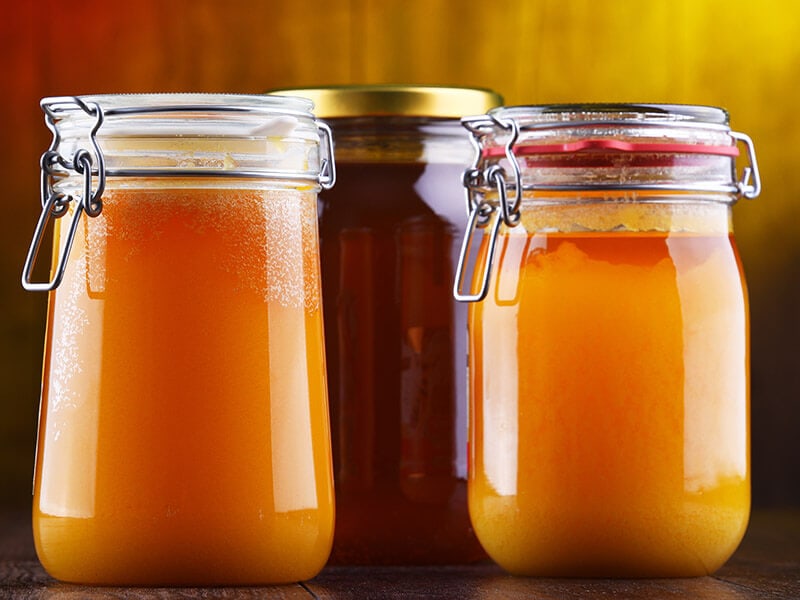
Step 1: Select A Good Container
You should be able to pick a suitable container based on the place where you live and the amount of honey you want to store. If you are still confused about what to choose, you can just go with a glass jar or ceramic pot as they are always the best choice to go to.
Step 2: Make Sure To Properly Wash And Clean Them
If you are reusing old pots or jars, cleaning them is a must because the old bacteria or odor can still be there and affect the quality of honey. You can consider boiling them for disinfectants and get rid of any lingering scent.
Drying them under sunlight will also help you get the rest of these smells out of them.
Step 3: Carefully Pour The Honey Into Your Chosen Container
As a result of being a liquid, honey is easily spilled when pouring, so you should use support tools like a funnel, a non-stick type to avoid wasting.
Step 4: Tightly Seal The Container
To ensure that no air or any kind of moisture can get through, double-check if you have cleared any foreign debris before doing so. Remember to wipe any drips on your container and around them as they can attract unwanted pests and the like.
Step 5: Choose A Good Spot To Place Your Honey
As long as your honey is airtight and stays at a cool, dry place, you can be at ease. There are many locations for you to pick. Pantry, kitchen cabinet, the cellar are some of the good options for you.
If you want to put them on your cupboard or table for immediate use, just be sure that no sunlight or humidity can reach them.
Tips: Keeping your container at room temperature is crucial because that’s the most suitable temperature for honey. Going too hot or too cool will all leave undesirable effects on them.
Some more useful tips you may want to know.
Different Types Of Honey And How To Handle Them
Now that you have the basic ideas of how to do things, next is a little deeper on what kind of honey you have and how to deal with each of them. Don’t be frustrated yet, they may look different, but the baseline for storage is still basically the same, stay dry and stay cool.
There are several different types of honey, and depending on which type, the storage method can be slightly different from each other. These are the four common types:
Raw Honey
Raw honey is probably the best type of honey you can expect with all the qualities at their top condition. Many people compare raw honey and manuka honey since they are both high-quality.
Original
Raw honey is honey that just comes out of the beehive and has not gone through any processed stage like filtering or heating, and it is simply made by extracting honey straight out of the honeycomb from the hive.
This type of honey can usually be obtained by buying directly from your local beekeeper and is the best to enjoy as the natural taste and nutrients are at their finest.
Storage
Raw honey tends to easily get fermented and crystallized. Without the procession, their sugar level is very high. There are still many bacteria left in them, so you need to pay more attention to the temperature and environment around them.
For most of the time, an airtight container at room temperature is enough. Make sure to stay away from any high heat and any source of moisture. They will make honey fermented faster.
Even if stored properly, it is likely that crystallization still happens. You don’t have to worry too much about this.
Crystallization is just the natural way of honey to preserve itself. The taste and its nature still stay the same.
Preferable environment: Room temperature at around 20 to 25°C, dry and cool, better to keep them in the dark place because it will help maintain the flavor better.
Processed Honey
The most common you can find in every shop or supermarket, noticeably for the appealing color and their texture and flavor stability.
Original
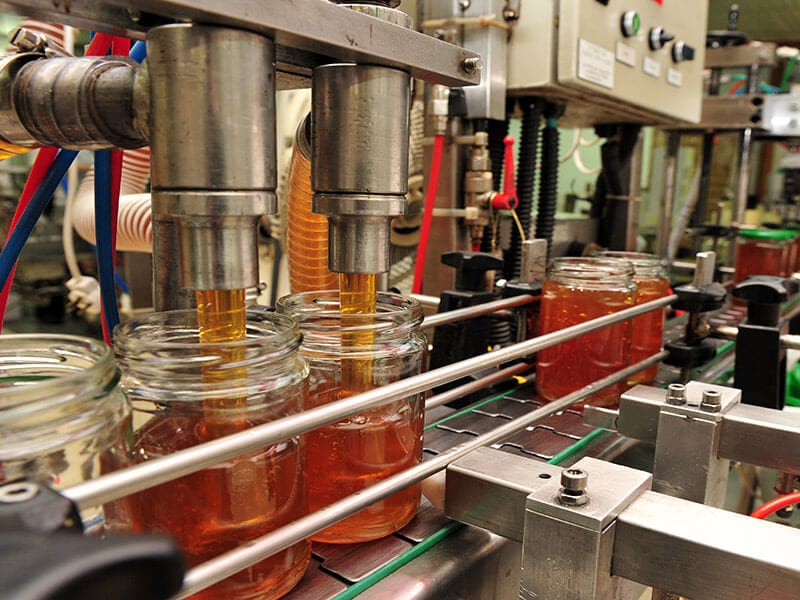
This is the kind of product that has gone through certain processing stages, most noticeably pasteurization.
Pasteurization is the process of treating food with mild heat to eliminate germs and extend shelf life, as for raw honey, the temperature is at 70°C and then rapidly cools down.
This treatment results in more visually appealing honey, but in exchange, it lowers the sugars level and destroys most of the beneficial enzymes, vitamins, bacteria, and minerals in raw honey.
Storage
Processed honey is less likely to be crystallized or fermented than raw honey due to its heat treatment that reduces the original level of sugar and enzymes.
This makes it the easiest type to store, you only need to keep it at room temperature, avoid any excess heat source, and it will stay gold for a long while.
Preferable environment: Room temperature around 20°C, dry and cool, avoid direct sunlight and heat.
Comb Honey
This is a kind of luxury product in the form of pure honey coming straight out of the beehive, rare, expensive, and also an excellent snack to enjoy.
Original
Comb honey is the original pure honey stage that honey bees produce, the rawest form of honey that you can find, receiving no processing or filtering. They even maintain the hexagon shape of beeswax cells.
Still filled with beeswax, the comb honey has a much different aroma and taste compared to liquid honey, totally edible, rather than an ingredient. It is more like a dessert or a snack.
Storage
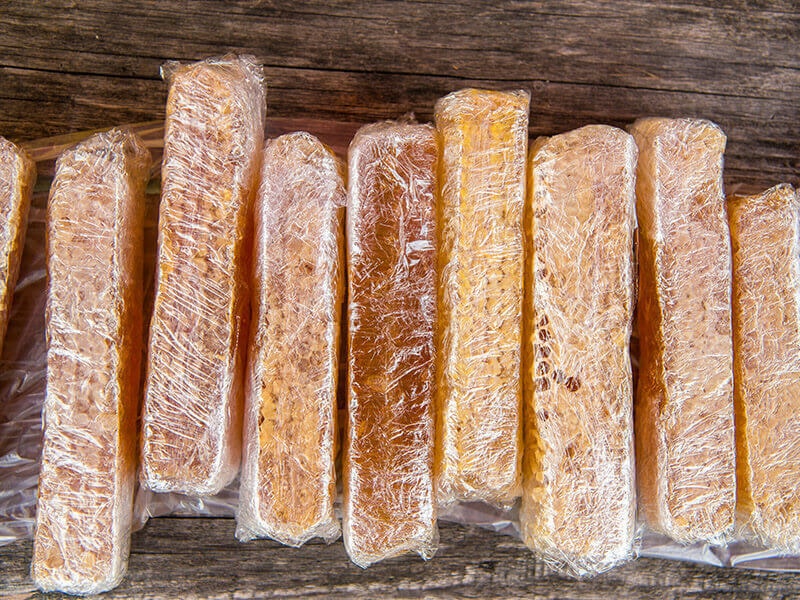
For this type of honey, their characteristic is almost the same as raw honey, but to enjoy it as a snack, you can store and preserve honeycomb by freezing them.
You just need to wrap them around a plastic wrap, put them in the freezer then it’s all good.
Preferable environment: The same with raw honey, but in addition, they can be stored by freezing for long-term usage.
Creamed Honey
Products that come from a rather unwanted process, nonetheless they prove to be a fine dessert that can be as good as ice cream.
Original
Creamed honey is honey that has gone through a controlled crystallization process. It is made by mixing 10% of crystallized honey with 90% of liquid honey, then stored at 14°C, the ideal temperature for crystallization. Within a week or two, you will have creamed honey.
The only differences between creamed and liquid honey are texture and thickness. When the honey has been controlled crystallized, its form is very soft and smooth, comparable to that of ice cream.
Because they are just liquid honey turned into cream, their value of nutrients is identical.
Storage
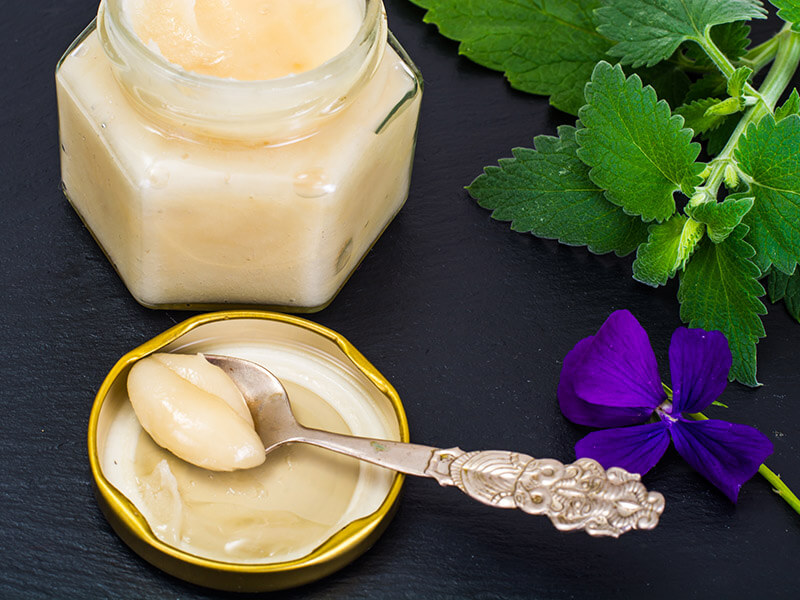
Unlike their liquid form, you don’t have to be concerned about crystallizing with creamed honey anymore.
But be aware that they can still be fermented if they are contacted to moisture, and they can melt back into liquid if the heat is too high.
That’s why even if they can still do fine at room temperature, it’s best to keep them somewhere cool and dry, like inside a refrigerator.
Preferable environment: cool temperature between 5 to 10°C, away from moisture and any heat source.
Each Type Of Honey Is Special On It Own
To help you understand clearly how valuable it is for each type of honey, here is a comparison chart, how much they cost, and how to obtain them.
The ones that require you to buy from the beekeepers are always harder to obtain and more expensive because of their quality and uniqueness.
And although processed honey may look like they are lacking behind, they are a friendly product that everyone can have and enjoy. That is also their unique value.
Things You Need To Consider When Storing
So far, you have learned how to store honey properly, but there are a few extra things for you to do even better.
In the end, there are only two factors that you need to take into account: air and heat.
It Is Not Necessary To Keep Honey In The Refrigerator
It won’t make them last longer or fresher. Instead, it will harden the honey, making it difficult for you to manage.
The Best Place Is Always A Cool, Dry Place

You must have noticed by now, honey dislikes change. When you put it into a certain environment, it would rather stay like that for the rest of its life.
Therefore, choosing a nice resting place for honey is important, so you don’t have to worry about it anymore since that’s also all it needs.
Place them somewhere away from the window, direct sunlight, and any heat-producing source. If your house tends to get warm easily, find the coolest spot to store them but remember to avoid any humid area.
It is best to keep storage honey inside your pantry or kitchen cabinet for they can provide a stable environment. It will also keep them out of children’s reach since the container is usually made from glass and can be quite dangerous for kids.
Freezing Is Also One Of Your Options
In case you want to keep a considerable amount of honey for long-term usage. As honey is in its solid stage, all the crystallization and fermentation can be prevented, and it can last for years.
Tips: Better to freeze them in an ice cube tray so that it will be easier for you to manage the amount whenever you want to thaw them.
Honey Can Last For A Lifetime
You must have wondered, and honey can last for very long, but just how long? The answer would be for as long as you need them, and all it takes is a proper way of storage.
Indefinitely is the right word to describe this. The shelf life of honey is exceptionally long, and they can last for a lifetime if carefully stored.
Their form and color may not stay the same over time, but you can still consume them just fine. There are many cases of honey still usable even after centuries have passed.
Despite their texture and appearance may change during certain conditions. Still, their nature always stays the same, low in moisture content and high in sugar, making it extremely hard for bacteria to reproduce in them as long as they are kept in a stable environment.
So you just need to seal them properly, keep them dry, and they will stay with you for as long as you want, be it any kind of honey.
Ever wonder why honey can stay good for such a long time? Because it is the natural enemy for bacteria
What If The Honey Has Already Crystallized?
You must have heard quite a lot about crystallization when it comes to honey, but what exactly is it? Does it mean your honey has gone bad? No need to worry because this may turn out to be a good sign for you.
What Is Crystallization?
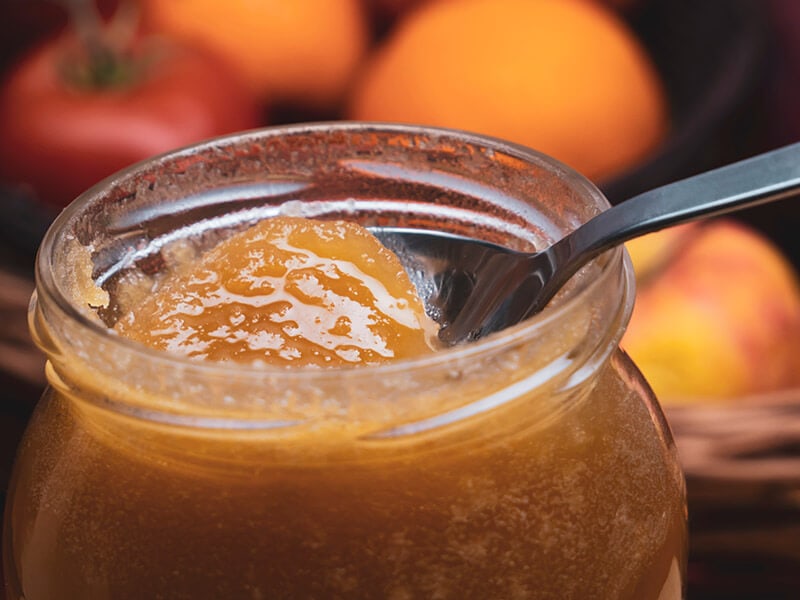
As you have already known, crystallization is not something bad, and it is merely the natural process of honey to preserve itself. It will happen to all kinds of liquid honey, whether raw or processed.
The main reason why it happens is because of honey’s composition. Naturally, they contain 70% sugar (including glucose and fructose), but they have less than 20% of water, which makes them unbalanced.
There’s just not enough water to keep all of those sugars dissolved, and the glucose which has much lower solubility, separate from the water forming those crystals.
Processed honey takes a longer time to crystallize due to its heat treatment, while this happens much faster to raw honey with its original sugar.
How To Decrystallize?
Crystallization won’t affect the taste or flavor of honey, and this can be proof of their quality since it’s a sign of fresh and pure honey.
But to many people, the looks of crystallized honey are not something they want to see in their precious honey jars, and if it’s also bothering you, there are some ways to fix this problem.
- The simplest solution is to just leave your honey container under sunlight for a moment, and it will slowly melt the crystal and return the honey to its liquid form without damaging any of the enzymes within.
- If you want a faster way, you may drop the container into some warm water. The temperature should not exceed 42°C, and let it sit until the honey softened and liquified itself. Remember to stir the honey occasionally.
Avoid using the microwave since it is hard to control the temperature as it gets hot too quickly and may risk altering the honey into caramel.
Crystallized honey? Not a problem, this will help you,
Fermented Honey, Should You Worry About it?
One day when you reach out to your honey jar, intend to have some of its sweetness just to find out it somehow has a different smell, and you notice something is off by the way it looks. Your honey might have already fermented at this point.
What Is Fermentation?
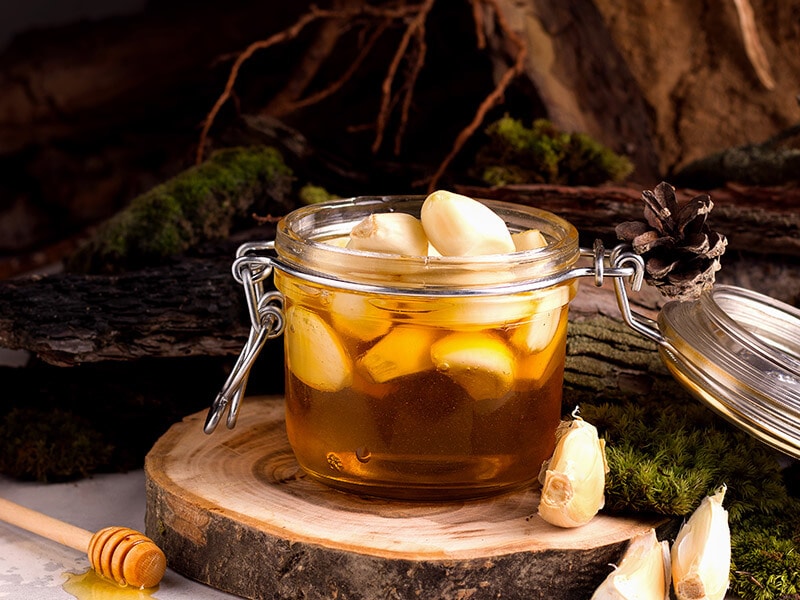
Fermentation is a natural stage of honey, resulting from being exposed to a high moisture environment, thus facilitating the yeast spores within to reproduce, causing fermentation.
This usually happens to raw honey and mostly depends on the water content in them, but temperature also plays a crucial role.
At below 11°C, yeast will stay inactive, but when it comes to between 12°C and 37°C, they will grow significantly. If honey gets moist at this temperature, it’s very likely to ferment. The sign is when it starts to give off a smell like wine, bubbles will show up and foam floating on the top.
What Can You Do?
Now that you have known what fermentation is and why honey can turn out to be like that, you should also know. However, this can be avoided without much effort by simply keeping your honey dry and cool.
But unfortunately, one day you accidentally let the honey be exposed to moisture, and now they are already showing signs of fermentation. What can you do about this situation?
It’s not easy to return the honey to its original stage after it has already fermented, even if you do, it will no longer be the same anymore. So the best option for you is to make the most out of them. Here are some of the choices you can make:
Consume Them With Food
Fermented honey is a good addition to yogurts, fruits, smoothies, or juice blends. Mix some of them into your dessert or enjoy it with breakfast, so you can have both the taste and healthy sweet of honey combined with the freshness of fruits.
Make Fermented Honey Garlic
One of the common recipes with fermented honey is to combine it with garlic to make fermented honey garlic, a great kind of sauce or flavor enhancer. You can add it to almost any kind of food, like vegetables, meat, fish, chicken, pizza, etc.
Watch this video: This recipe is the best thing you can get from fermented honey
FAQs
If you still have some questions in mind about how to keep your honey safe or some trivia thing about them, here are some more pieces of information for you to look at:
Stay Fresh And Stay Gold
Someday when you get yourself a jar of honey, the storage is very simple and straightforward. Just place it in your kitchen cabinet, pantry, away from sunlight and heat, make sure it has been tightly sealed. With those simple steps, your honey can last for as long as you need them.
Lastly, If you think the information and tips about honey and how to store them are useful, feel free to spread and share them with everyone, your friends, your family so they can all enjoy the fresh and healthy honey.
References
- en.wikipedia.org.2021. Honey – Wikipedia.
- Agricultural Marketing Resource Center (AgMRC). 2021. Bees.
- John Skinner, The University of Tennessee., 2019.

